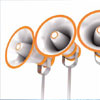
The Complexity of Mass Notification
When there is a crisis on campus, no matter where the student is at that time, it is imperative that he or she be notified of impending danger. Without a well-planned mass notification system, coupled with proper procedures, the campus opens itself up to legal liability and financial exposure as well as potentially bad PR.
- By Ralph C. Jensen
- Dec 01, 2011
To better understand what is needed and the current state of
mass notifications, Siemens undertook a detailed analysis of U.S.
colleges and universities, taking a hard look at information provided
to the government as part of the Clery Act. The company
released the results in October in a white paper.
The Clery Act is a federal mandate requiring all institutions
of higher education that participate in federal financial aid to
disclose information about crime on their campuses and in surrounding
communities.
“A multitude of communications tools are available today to
instantaneously and simultaneously send messages and alerts to
large groups of people. However, no one tool is capable of reaching
everyone at once. Comprehensive, multi-modal mass notification
systems that incorporate various layers of messaging and are
managed from a single command center are the most effective
way to reach the maximum number of people and ensure consistency
of message,” the Siemens white paper stated.
Public and private colleges and universities are affected by the
mandates of the Clery Act, and failure to comply can result in
fines and sanctions on the federal level. In 2010, there were 77
Clery Reports filed, coming from 34 private, 31 public and 12
community colleges in each region of the United States. Enrollments
also ranged from 1,000 to as many as 100,000 students.
The report seemed to indicate that community colleges are
least likely to implement a layered, emergency notification system,
with 75 percent of the community colleges ranking at level
1 or 2. Level 1 is a rudimentary system with the most simplistic
emergency notification capabilities, generally consisting of a nonlayered
approach with less than three modalities in one or two
categories. Level 2 is multi-dimensional where a non-layered approach
to emergency communications incorporates between four
and six different modalities in one or two categories.
The categories include:
- At your side. The use of SMS/text, e-mail, voicemail, call-in
emergency hotline, university website, internal portal or blog.
- Inside. Use of a public address system, digital signage, desktop
alerting, tone alert radios, voice-enabled fire alarm panels or
posted notices.
- Outside. Outdoor public address system, warning sirens, mobile
loud-speakers on vehicles, blue light towers and outdoor
emergency phones.
- Extended. Social media, such as Facebook, Twitter and others,
and CCTV.
Sixty-one percent of public universities ranked as a level 3 or
4, with several modes of communication that can easily and effectively
reach students, faculty, staff, administrators and visitors.
Only one public school was rated as a level 1, relying on SMS/
text, e-mail and voicemail to communicate with those people on
campus. All remaining schools used between four to 12 notification
modalities on campus.
There also appears to be a direct correlation between size of
campus and the sophistication of the mass notification system.
Bigger schools generally have more complex notification systems
in place. Private schools are about right in the middle of the
road with their implementation of notification systems. Of those
schools analyzed, 70 percent were rated as Level 2 or 3, meaning
they had moderately sophisticated systems in place.
The highest level of sophistication was found in southern
states with the largest number of schools rating Level 4 of any
region. The South also had the most mature mass notification
systems in place; and 29 percent of the schools in the region used
a layered approach that includes all modes in all four categories.
Nearly half of the schools use Twitter and Facebook to communicate
during emergencies.
“School enrollments range from 1,000 to upwards of 100,000
students at the college and university campuses reviewed in the
study. Not surprisingly, there appears to be a direct correlation
between the size of the school and the sophistication of the mass
notification systems in use,” the study noted.
“Among the schools analyzed, those with enrollments of more
than 8,000 students are more likely to have multi-layered notification
systems. Twenty-one percent of universities in this category
ranked as Level 4, as compared to only 10 percent of schools with
less than 8,000 students enrolled,” the study concluded.
Digital signage seemed to be less prevalent on college campuses,
though 77 percent of the colleges and universities in the
study indicated the use of outdoor systems to alert people on
campus of an imminent threat. The most widely used outdoor
modality is the blue light/outdoor emergency phones, which
are available on 60 percent of campuses reviewed. Nearly 25
percent of all campuses reviewed use an outdoor warning siren
and public address systems.
Universities and colleges have a wide array of options that
can be used for communication at each of their communities during
an emergency. Few of the campuses actually demonstrated
the type of comprehensive, multi-layered system that is critical
to reach the masses when there is a crisis. The most widespread
method is the Web-based alerting system as well as short message
services, texts, mass e-mails, voicemail blasts, website postings
and the use of social media. These all work well, but they have to
be turned on, and if any factor such as a power failure or a wireless
network failure arises, the message won’t be delivered.
The security and safety of students, faculty and staff is of the
utmost importance. The right protocols and technology must be
in place to be effective and provide the ability to communicate
with everyone.
This article originally appeared in the December 2011 issue of Security Today.